© Copyright Atlanta Coin Expositions, 2008-2025. All Rights Reserved.
Several of the links on the pages within this web site go to affiliate vendors.
A vendor affiliation can mean a small monetary compensation to the web site owner at no additional cost to you.
Several of the links on the pages within this web site go to affiliate vendors.
A vendor affiliation can mean a small monetary compensation to the web site owner at no additional cost to you.
Coin Show
Information
Shop
General
Next Monthly Coin Show
Coin Show - Monthly Notes for September 2022
Mark your calendar and join us at the next show on Sunday, October 9, 2022, in the Joe Mack Wilson ballroom.
The ballroom will be filled with dealers and their displays of coins, currency, bullion, exonumia, scripophily, semi-precious stones, jewelry and other interesting items in their showcases.
Visitors are welcome to the show to buy, sell, trade or just view the history found in the many displays. People can also bring coins and currency to the show for a free verbal appraisal of the items in the current market.
The show is open from 9am - 5pm for guests to visit the bourse for buying, selling, trading or just enjoying the history of the different items in the dealers' displays. The most dealers and opportunities are available between 10am and 2pm.
Should circumstances impact the show, check with this web site, the recorded show message (770-772-4359) or join our mailing list to receive information about the shows.
Make a reminder note and visit the next Greater Atlanta Coin Show on Sunday, October 9, 2022 in the Joe Mack Wilson ballroom to join the fun and view the items on the bourse.
The ballroom will be filled with dealers and their displays of coins, currency, bullion, exonumia, scripophily, semi-precious stones, jewelry and other interesting items in their showcases.
Visitors are welcome to the show to buy, sell, trade or just view the history found in the many displays. People can also bring coins and currency to the show for a free verbal appraisal of the items in the current market.
The show is open from 9am - 5pm for guests to visit the bourse for buying, selling, trading or just enjoying the history of the different items in the dealers' displays. The most dealers and opportunities are available between 10am and 2pm.
Should circumstances impact the show, check with this web site, the recorded show message (770-772-4359) or join our mailing list to receive information about the shows.
Make a reminder note and visit the next Greater Atlanta Coin Show on Sunday, October 9, 2022 in the Joe Mack Wilson ballroom to join the fun and view the items on the bourse.
1853 Half Cent Coin
1817 One Cent Coin
1866 Two Cent Coin
1867 Two Cent Coin
1858 Three Cent Coin
The September 2022 Greater Atlanta Coin Show welcomed many visitors to a fun-filled bourse packed with dealers and their displays of coins, currency, bullion and other collectibles.
We appreciate our visitors, our dealers, our security and the hotel's staff for the contributions to making the show a place to spend a few hours one Sunday each month. Thank you to one and all.
Please note, it's best to arrive at the show early in the day. Several of our dealers have long drives or Sunday evening plans and leave by mid-afternoon.
Guests to the show are welcome to buy, sell, trade or just view the history found among the many displays of coins, currency, bullion and other collectibles. Of course, admission is always free.
We appreciate our visitors, our dealers, our security and the hotel's staff for the contributions to making the show a place to spend a few hours one Sunday each month. Thank you to one and all.
Please note, it's best to arrive at the show early in the day. Several of our dealers have long drives or Sunday evening plans and leave by mid-afternoon.
Guests to the show are welcome to buy, sell, trade or just view the history found among the many displays of coins, currency, bullion and other collectibles. Of course, admission is always free.
Dealers at the show bring a variety of skills and interests to the show. They provide displays from the ancient to the modern, from historical to current, from loose good to slabbed mint state, from coins to currency to bullion to medals to stock certificates to jewelry to other types of interesting items. All of these are available at the show each month.
Sometimes people receive gifts or an inheritance of numismatic items. Dealers at the show provide free verbal appraisals based on current market values for coins and currency brought to the show for evaluation.
Sometimes people receive gifts or an inheritance of numismatic items. Dealers at the show provide free verbal appraisals based on current market values for coins and currency brought to the show for evaluation.
Of particular note, for those not familiar with the collection of money, especially old coins and currency, please do NOT clean the items before an experienced dealer can provide an evaluation of their worth. Inexperienced cleaning destroys their numismatic value. Many times the "ugly dirt" adds significant value.
For the September show, Mother Nature gave us a nice day with on and off sunshine and rain. Though still summertime on the calendar, fall is on the horizon with the dogwood leaves having a hint of red along with other trees beginning to shed some of their leaves.
At the hotel, we noticed a group of motorcycle riders. After a quick, curious chat with them, they hailed from Germany and were here to tour the southeast states. We hope their tour was interesting and safe.
On another interesting note, one of our show guests walked around the bourse using two cell phones as he viewed the displays.
Upon investigation, the gentleman did not speak any English. He used one of the cell phones as his interpreter. What an intriguing way to make technology's translate function be your friend.
Now, for fun this month, let's take a look at a few different cent items seen at the show.
For the September show, Mother Nature gave us a nice day with on and off sunshine and rain. Though still summertime on the calendar, fall is on the horizon with the dogwood leaves having a hint of red along with other trees beginning to shed some of their leaves.
At the hotel, we noticed a group of motorcycle riders. After a quick, curious chat with them, they hailed from Germany and were here to tour the southeast states. We hope their tour was interesting and safe.
On another interesting note, one of our show guests walked around the bourse using two cell phones as he viewed the displays.
Upon investigation, the gentleman did not speak any English. He used one of the cell phones as his interpreter. What an intriguing way to make technology's translate function be your friend.
Now, for fun this month, let's take a look at a few different cent items seen at the show.
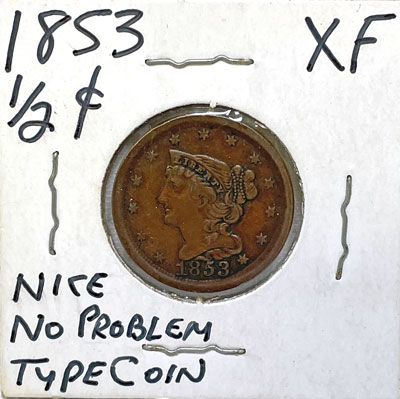
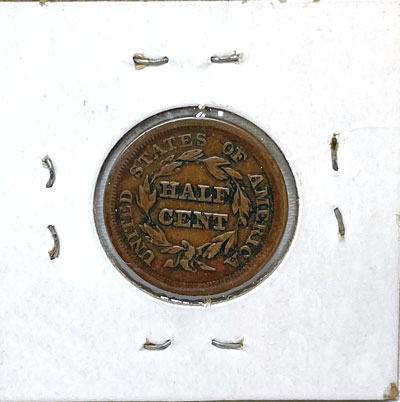
Congress authorized the lowest denomination coin in 1792, the half cent.
The US Mint began producing the coin in 1794 and continued until the last year of production in 1857.
During this timeframe, production of the half cent did not occur every year, and in some years the Mint only struck proof half cent coins.
The varieties through the years include the Liberty Cap, 1794-1797, the Draped Bust, 1800-1808, the Classic Head, 1809-1836, and the Braided Hair, 1840-1857.
As a result of the sporadic production, half cent coins can be scarce, and finding circulation strikes in nice condition can be difficult.
Our example is an 1853 coin struck at the Philadelphia mint.
The US Mint began producing the coin in 1794 and continued until the last year of production in 1857.
During this timeframe, production of the half cent did not occur every year, and in some years the Mint only struck proof half cent coins.
The varieties through the years include the Liberty Cap, 1794-1797, the Draped Bust, 1800-1808, the Classic Head, 1809-1836, and the Braided Hair, 1840-1857.
As a result of the sporadic production, half cent coins can be scarce, and finding circulation strikes in nice condition can be difficult.
Our example is an 1853 coin struck at the Philadelphia mint.
That year, the Mint produced less than 130,000 half cent coins for circulation.
The early Braided Hair years only saw proof coins made with circulation strikes beginning in 1849.
The Mint produced just over 540,000 of the circulation strike Braided Hair half cent coins before ending the coin in 1857.
Oddly, a bill in Congress in 1912 almost resurrected the half cent coin. It passed the House but did not pass in the Senate.
Though not professionally graded, this is a nice coin with wear just on the high points of the hair and leaves. Hair lines are still distinct, the beads are all visible, and LIBERTY is clearly shown.
This coin provides a nice view into the early years of the US Mint and our coinage history.
The early Braided Hair years only saw proof coins made with circulation strikes beginning in 1849.
The Mint produced just over 540,000 of the circulation strike Braided Hair half cent coins before ending the coin in 1857.
Oddly, a bill in Congress in 1912 almost resurrected the half cent coin. It passed the House but did not pass in the Senate.
Though not professionally graded, this is a nice coin with wear just on the high points of the hair and leaves. Hair lines are still distinct, the beads are all visible, and LIBERTY is clearly shown.
This coin provides a nice view into the early years of the US Mint and our coinage history.

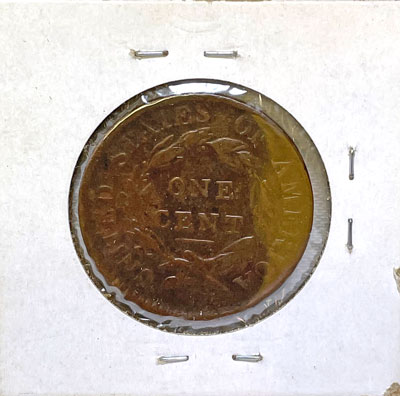
Our next cent coin comes from the Large Cent family of coins begun in 1793 and ending in 1857.
The US Mint began their production of coins with the half cent and large one cent coins.
Through the years, the Large Cent coin had different designs and different varieties.
The Large Cent coins struck by the US Mint included the Liberty Cap, 1793-1796, the Draped Bust, 1796-1807, the Classic Head, 1808-1814, and the Liberty Head, 1816-1857.
However, varieties exist within the main designs of the Large Cent.
Within the Liberty Head design, the Mint struck the Matron Head or Coronet Head Large Cent variety from 1816-1835.
The US Mint began their production of coins with the half cent and large one cent coins.
Through the years, the Large Cent coin had different designs and different varieties.
The Large Cent coins struck by the US Mint included the Liberty Cap, 1793-1796, the Draped Bust, 1796-1807, the Classic Head, 1808-1814, and the Liberty Head, 1816-1857.
However, varieties exist within the main designs of the Large Cent.
Within the Liberty Head design, the Mint struck the Matron Head or Coronet Head Large Cent variety from 1816-1835.
Our example, the 1817 Large Cent Coin, comes from two different varieties within that year.
The US Mint struck a 13-star variety and a 15-star variety for a total of just under four million of the coins in that year.
Our example shows the 13-star Matron Head Large Cent coin design, though the 15-star coin is more desirable.
Interestingly, after the Civil War, people found a sealed keg containing 14,000 large cent coins under a railway platform in Georgia. The years included 1816-1820 and were in mostly mint state condition.
Today, these dates in high grades were probably from that discovery.
Though the right date, this example is not in mint state condition. It is, however, a nice example of an early large cent coin.
The US Mint struck a 13-star variety and a 15-star variety for a total of just under four million of the coins in that year.
Our example shows the 13-star Matron Head Large Cent coin design, though the 15-star coin is more desirable.
Interestingly, after the Civil War, people found a sealed keg containing 14,000 large cent coins under a railway platform in Georgia. The years included 1816-1820 and were in mostly mint state condition.
Today, these dates in high grades were probably from that discovery.
Though the right date, this example is not in mint state condition. It is, however, a nice example of an early large cent coin.

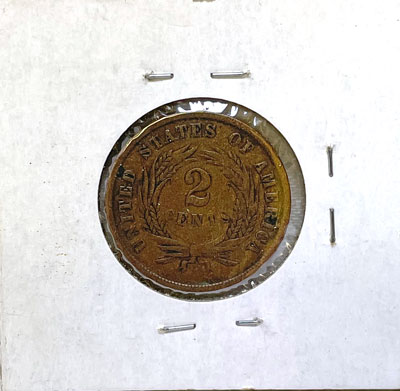
Our next two examples came from the two-cent coin family.
The same legislation that birthed the small one-cent coin also allowed for a two-cent coin using the same metal composition.
Produced beginning in 1864 and ending in 1873, the two-cent coin enjoyed only one design with a shield on the obverse and a wreath on the reverse.
Of importance, the two-cent coin became the first coin to include IN GOD WE TRUST as part of the design.
The Civil War resulted in a strong religious feeling. In 1861, the Reverend Mark R. Watkinson of Ridleyville, Pennsylvania, a Baptist minister, wrote a letter to Secretary pf the Treasury, Salmon P. Chase, requesting “the recognition of the Almighty God in some form on our coins.”
The same legislation that birthed the small one-cent coin also allowed for a two-cent coin using the same metal composition.
Produced beginning in 1864 and ending in 1873, the two-cent coin enjoyed only one design with a shield on the obverse and a wreath on the reverse.
Of importance, the two-cent coin became the first coin to include IN GOD WE TRUST as part of the design.
The Civil War resulted in a strong religious feeling. In 1861, the Reverend Mark R. Watkinson of Ridleyville, Pennsylvania, a Baptist minister, wrote a letter to Secretary pf the Treasury, Salmon P. Chase, requesting “the recognition of the Almighty God in some form on our coins.”
The Reverend added, “This would relieve us from the ignominy of heathenism. This would place us openly under the Divine protection we have personally claimed.”
The Department of the Treasury including the US Mint considered several different mottos including "GOD OUR TRUST" and "IN GOD WE HOPE."
The final choice, "IN GOD WE TRUST," has graced our coinage since that time.
In 1866, the US Mint produced just under 3.2 million of the two-cent coins.
This coin is a nice example, probably between F-12 Fine and VF-20 Very Fine, of the two-cent coin family.
The Department of the Treasury including the US Mint considered several different mottos including "GOD OUR TRUST" and "IN GOD WE HOPE."
The final choice, "IN GOD WE TRUST," has graced our coinage since that time.
In 1866, the US Mint produced just under 3.2 million of the two-cent coins.
This coin is a nice example, probably between F-12 Fine and VF-20 Very Fine, of the two-cent coin family.
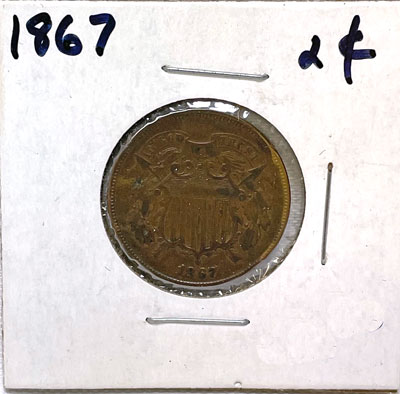
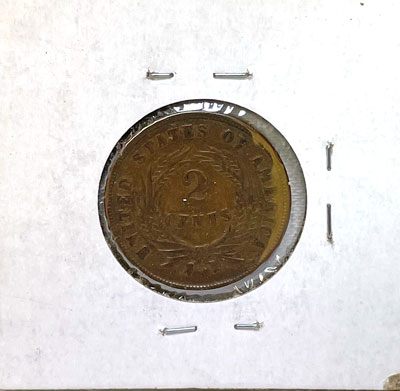
Our next example is another of the short-lived two-cent coin family.
Begun in 1864 with not quite 20 million two-cent coins produced, each subsequent year saw a reduction in the production of the coins.
A dramatic reduction occurred in 1866 with even less produced in 1867.
The Philadelphia Mint struck just over 2.9 million of the shield two-cent coins, of which this is just one example.
The production decreased to 65,000 for circulation in 1872, and just proof coins struck in 1873, the last year.
Begun in 1864 with not quite 20 million two-cent coins produced, each subsequent year saw a reduction in the production of the coins.
A dramatic reduction occurred in 1866 with even less produced in 1867.
The Philadelphia Mint struck just over 2.9 million of the shield two-cent coins, of which this is just one example.
The production decreased to 65,000 for circulation in 1872, and just proof coins struck in 1873, the last year.
When first proposed the Director of the Mint submitted two different designs from James B. Longacre for the two-cent coin to the Secretary of the Treasury.
One included Washington on the obverse while the second included the shield.
Both the Director and the Secretary favored the shield design.
Perhaps of interest, this shield design on the two-cent coin looks to be the basis for the shield five-cent coin begun in 1866. The obverse design on the two coins is not exactly the same, however there are many similarities.
Our 1867 coin example shows wear, however it is still a nice specimen of a short-lived coinage production run.
One included Washington on the obverse while the second included the shield.
Both the Director and the Secretary favored the shield design.
Perhaps of interest, this shield design on the two-cent coin looks to be the basis for the shield five-cent coin begun in 1866. The obverse design on the two coins is not exactly the same, however there are many similarities.
Our 1867 coin example shows wear, however it is still a nice specimen of a short-lived coinage production run.
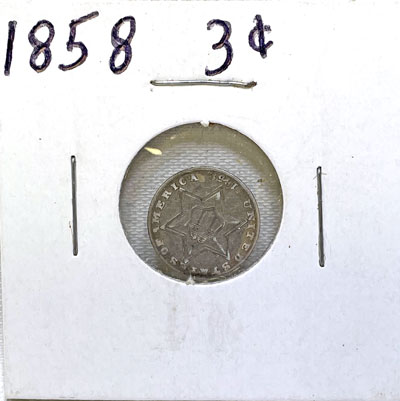
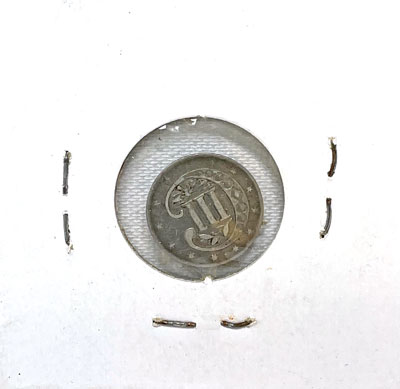
Staying in the cents, our last example this month is from the three-cent or trime coins.
The US Mint produced the silver three-cent coin from 1851-1873 and the nickel three-cent coin from 1865-1889.
This one from 1858 is one from the silver years.
A couple of oddities generated the need for the silver three-cent coin.
First, a reduction in postage rates had people clamoring for a similar denomination in the coinage.
Second, an increase in silver metal prices had people hoarding their silver coins.
Instead of making the new three-cent silver coin in the 90% silver 10% copper ratio as with other coins, the Treasury Department decided to make the coin of 75% silver and 25% copper.
The US Mint produced the silver three-cent coin from 1851-1873 and the nickel three-cent coin from 1865-1889.
This one from 1858 is one from the silver years.
A couple of oddities generated the need for the silver three-cent coin.
First, a reduction in postage rates had people clamoring for a similar denomination in the coinage.
Second, an increase in silver metal prices had people hoarding their silver coins.
Instead of making the new three-cent silver coin in the 90% silver 10% copper ratio as with other coins, the Treasury Department decided to make the coin of 75% silver and 25% copper.
They hoped with that ratio, people would not hoard the coins, but on the other hand would not reject the coins as being not worth the three cents.
Sadly, though, people disliked the trime for other reasons.
The coin was so small and so thin, it could easily be lost. When average wages were less than 10 cents an hour, losing a thin three-cent coin was a big problem.
Additionally, the coin's composition made it discolored and dirty-looking quickly during circulation.
As a result of the downsides to the three-cent silver coin, people began calling it a fish scale.
This particular fish scale has wear and shows the discoloration as noted by the early users.
The silver coin provides insights and is an example of the challenges facing the people and the Mint in producing a coin people wanted and used.
Sadly, though, people disliked the trime for other reasons.
The coin was so small and so thin, it could easily be lost. When average wages were less than 10 cents an hour, losing a thin three-cent coin was a big problem.
Additionally, the coin's composition made it discolored and dirty-looking quickly during circulation.
As a result of the downsides to the three-cent silver coin, people began calling it a fish scale.
This particular fish scale has wear and shows the discoloration as noted by the early users.
The silver coin provides insights and is an example of the challenges facing the people and the Mint in producing a coin people wanted and used.
